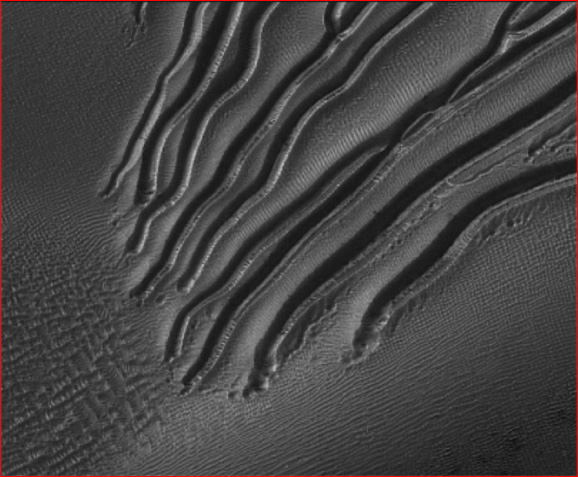
home •
about •
essential guide •
picture of the day •
thunderblogs •
news •
multimedia •
predictions •
products •
get involved •
contact
picture of the day archive subject index
The image shown here is just a small segment of a very large HiRISE image of the
mysterious channels running down a “sand dune” in Russell Crater on Mars.
May 16, 2007
The “Gullies” of Russell Crater on Mars (2)
Thanks to a recent high-resolution image taken by the HiRISE instrument, it is now clear that conventional “explanations” of the Russell Crater channels have failed. More alive than ever: the electrical interpretation.The most recent and highest-resolution image of the ravines of Russell Crater (the subject
of our Picture of the Day for May 14, 2007) are now in. For a critical observer, a
close-up look at the formations should eliminate once and for all the idea that these
“gullies” were created by fluid erosion. The huge HiRISE image can be accessed selectively by zooming in on any region.The HiRISE image provides stunning new support for an electrical interpretation. Channels cut by electric discharge machining will often produce associated non-random cratering and crater chains, now revealed by this latest image. Though the ravines all run downhill, the higher resolution images show that they do not consistently follow topography in the fashion of fluid flow. In electrical terms, that is not surprising. The channels reveal no breeches of levee walls and no outflow at their termination. Within the channels themselves, no evidence can be found of sediment or debris being carried along by fluid. Many of the channels terminate in cleanly cut craters.
The “fishbone” formations below the channels find counterparts in lightning scars (as illustrated in a forthcoming TPOD). Finely cut transverse grooves along the channel walls are diagnostic of the filamentary coronas of electric arcs. The miniature, patterned “dunes” on the vastly larger “dune” are diagnostic of electrostatic sculpting. Dark spotting and darkened nodules scattered about the region point directly to surface effects of positively charged particle beams in the laboratory. Indeed, it is no exaggeration to say that every defining feature of the Russell Crater anomalies, though challenging standard theory, has an undeniable analog in electric discharge scarring.
Of course, these considerations are not on the mind of the specialists analyzing the image, because they are still bound by the “electrically neutral solar system.” Here is what the HiRISE team has to say about the dramatically enhanced view of the ravines:
“Hundreds of enigmatic small channels are seen to carve into the slopes of these dark sand dunes lying within Russell Crater on Mars. These features were previously identified as gullies in images from the Mars Orbiter Camera (MOC) on Mars Global Surveyor, but the higher resolution HiRISE image brings out many new details and mysteries.” And yet, immediately after this acknowledgment an imprisoning theoretical assumption rears its head. “The channels extend from near the top of the dunes to their bases, indicating that some fluid material carved into the sand. The channels commonly begin as smaller tributaries joined together, suggesting several sources of fluid."
It seems that obsolete assumptions still condition today’s scientific observations, so that in the case at hand everything remains an anomaly: “Distinct dark spots are located near where the channels seem to originate. Several channels appear to originate at alcoves. Several of these channels have sinuous middle reaches while others are straighter. Further down slope, some channel edges appear elevated above the surrounding terrain, particularly in the lower reaches. The channels seem to terminate abruptly, with no deposition of material, unlike at the bases of some other gullies on Mars that are not on dunes.”
It is a tragedy that planetary scientists, working with stunning technological achievements, are constrained from seeing what is before them. The authors of the HiRISE page write--
“One hypothesis for the origin of the channels, which has previously been proposed by the MOC team, is that CO2 (or maybe H2O) frost is deposited on the dunes in shadows or at night. Some frost may also be incorporated into the internal parts of the dunes due to natural avalanching. When the frost is eventually heated by sunlight, rapid sublimation triggers an avalanche of fluidized sand, forming a gully. HiRISE will continue to target small channel features such as these and may return to search for any changes over time.”
Browse the massive HiRISE image for yourself. Do you see evidence of avalanching? We can see none--though across every inch of the image we do see the patterns of electrical discharge.But there is much more evidence to consider. If electrical activity created the ravines under discussion, it is highly unlikely that the effects would be limited to these particular anomalies. What can the Russell Crater dunes reveal to us about the pervasive enigmas lying farther to the south, including the mystery of the Martian spiders? (See stories here, here and here.)
Electrical events occurring today on Mars may indeed change forever our outdated ideas about planetary evolution.
Coming May 18: Martian “Dark Spots” Explained?NEW - Please Visit Our Forum
![]()
home •
thunderblogs •
forum •
picture of the day •
resources •
team •
updates •
contact us
EXECUTIVE EDITORS:
David Talbott, Wallace Thornhill
MANAGING EDITORS:
Steve Smith, Mel Acheson
CONTRIBUTING EDITORS: Michael Armstrong, Dwardu Cardona,
Ev Cochrane,
C.J. Ransom, Don Scott, Rens van der Sluijs, Ian Tresman
WEBMASTER: Brian Talbott
Copyright 2007: thunderbolts.info
